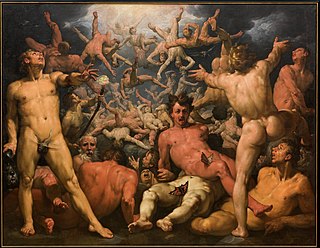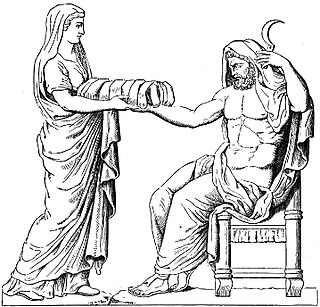Related Research Articles

Hesiod was an ancient Greek poet generally thought to have been active between 750 and 650 BC, around the same time as Homer. He is generally regarded by Western authors as 'the first written poet in the Western tradition to regard himself as an individual persona with an active role to play in his subject.' Ancient authors credited Hesiod and Homer with establishing Greek religious customs. Modern scholars refer to him as a major source on Greek mythology, farming techniques, early economic thought, Archaic Greek astronomy and ancient time-keeping.

In ancient Greek mythology and religion, Leto is a goddess and the mother of Apollo and Artemis. She is the daughter of the Titans Coeus and Phoebe, and the sister of Asteria.

In Greek mythology, the Titans were the pre-Olympian gods. According to the Theogony of Hesiod, they were the twelve children of the primordial parents Uranus (Sky) and Gaia (Earth), with six male Titans—Oceanus, Coeus, Crius, Hyperion, Iapetus, and Cronus—and six female Titans, called the Titanides or "Titanesses" —Theia, Rhea, Themis, Mnemosyne, Phoebe, and Tethys. Cronus mated with his older sister Rhea, who then bore the first generation of Olympians: the six siblings Zeus, Hades, Poseidon, Hestia, Demeter, and Hera. Certain descendants of the Titans, such as Prometheus, Atlas, Helios, and Leto, are sometimes also called Titans.

Rhea or Rheia is a mother goddess in ancient Greek religion and mythology, the Titaness daughter of the earth goddess Gaia and the sky god Uranus, himself a son of Gaia. She is the older sister of Cronus, who was also her consort, and the mother of the five eldest Olympian gods and Hades, king of the underworld.
In Greek mythology, the Meliae were usually considered to be the nymphs of the ash tree, whose name they shared.

In Greek mythology and religion, Themis is the goddess and personification of justice, divine order, law, and custom. She is one of the twelve Titan children of Gaia and Uranus, and the second wife of Zeus. She is associated with oracles and prophecies, including the Oracle of Delphi. Her symbol is the Scales of Justice.
In Greek mythology, Coeus, also called Polus, was one of the Titans, one of the three groups of children born to Uranus (Sky) and Gaia (Earth).

In Greek mythology the Horae, Horai or Hours were the goddesses of the seasons and the natural portions of time.

Theia, also called Euryphaessa "wide-shining", is one of the twelve Titans, the children of the earth goddess Gaia and the sky god Uranus in Greek mythology. She is the Greek goddess of sight and vision, and by extension the goddess who endowed gold, silver, and gems with their brilliance and intrinsic value. Her brother-consort is Hyperion, a Titan and god of the sun, and together they are the parents of Helios, Selene, and Eos. She seems to be the same figure as Aethra, who is the consort of Hyperion and mother of his children in some accounts. Like her husband, Theia features scarcely in myth, being mostly important for the children she bore, though she appears in some texts and rare traditions.
In Greek mythology, Iapetus, also Japetus, is a Titan, the son of Uranus and Gaia and father of Atlas, Prometheus, Epimetheus, and Menoetius. He was also called the father of Buphagus and Anchiale in other sources.

In Greek mythology, Epimetheus was the brother of Prometheus, a pair of Titans who "acted as representatives of mankind". They were the sons of Iapetus, who in other contexts was the father of Atlas. While Prometheus is characterized as ingenious and clever, Epimetheus is depicted as foolish.
In Greek mythology, Hyperion was one of the twelve Titan children of Gaia (Earth) and Uranus (Sky). With his sister, the Titaness Theia, Hyperion fathered Helios (Sun), Selene (Moon) and Eos (Dawn).
The Homeric Hymns are a collection of thirty-three anonymous ancient Greek hymns celebrating individual gods. The hymns are "Homeric" in the sense that they employ the same epic meter—dactylic hexameter—as the Iliad and Odyssey, use many similar formulas and are couched in the same dialect. While the modern scholarly consensus is that they were not written during the lifetime of Homer himself, they were uncritically attributed to him in antiquity—from the earliest written reference to them, Thucydides (iii.104)—and the label has stuck. "The whole collection, as a collection, is Homeric in the only useful sense that can be put upon the word," A. W. Verrall noted in 1894, "that is to say, it has come down labeled as 'Homer' from the earliest times of Greek book-literature."

The Life of Homer, whose unknown author is referred to as Pseudo-Herodotus, is one among several ancient biographies of the Greek epic poet, Homer. It is distinguished from the others by the fact that it contains, in its first lines, the claim to have been compiled by the early historian Herodotus:
Herodotus of Halicarnassus wrote the following history of Homer's background, upbringing and life, and sought to make his account complete and absolutely reliable.

Ancient accounts of Homer include numerous passages in which archaic and classical Greek poets and prose authors mention or allude to Homer. In addition, they include the ten biographies of Homer, often referred to as the Lives.
Ianeira or Ianira or Janira was a name attributed to three characters in Greek mythology.

The Potamoi are the gods of rivers and streams of the earth in Greek mythology.
The Contest of Homer and Hesiod is a Greek narrative that expands a remark made in Hesiod's Works and Days to construct an imagined poetical agon between Homer and Hesiod. In Works and Days, Hesiod claims he won a poetry contest, receiving as the prize a tripod, which he dedicated to the Muses of Mount Helicon. A tripod, believed to be Hesiod's dedication-offering, was still being shown to tourists visiting Mount Helicon and its sacred grove of the Muses in Pausanias' day, but has since vanished.

The "Precepts of Chiron" is a now fragmentary Greek didactic poem that was attributed to Hesiod during antiquity. The poem was presented in the voice of Chiron, the wise centaur, as he instructed a young Achilles. To judge from the few fragments that are preserved in other ancient authors, the hero's lessons consisted of moral, religious and practical advice. As such, the poem shows affinities not only with the Hesiodic Works and Days, with which it shared its hexameter verse form, but also with the gnomic elegies of Theognis.
The "Kiln", or "Potters", is a 23-line hexameter poem that was variously attributed to Homer or Hesiod during antiquity, but is not considered the work of either poet by modern scholars. The poem constitutes an appeal to Athena to grant success to certain unnamed potters if they pay for the poet's song, followed by a series of curses to be enacted should they not reimburse him. It has been included among the Epigrams of Homer, as epigram XIV.
References
- ↑ Hesiod; Homer; Evelyn-White, Hugh G. (Hugh Gerard), d. 1924 Hesiod, the Homeric hymns, and Homerica London : W. Heinemann ; New York : Putnam p.467
- ↑ Evelyn-White p.xxxix-xl
- ↑ John M. Cooper ed. Plato; the complete works Indianapolis, Ind. : Hackett Pub. 1997 p. 541
- ↑ Evelyn-White p.466
- ↑ Evelyn-White p.467
- ↑ Evelyn-White p.xlvii
